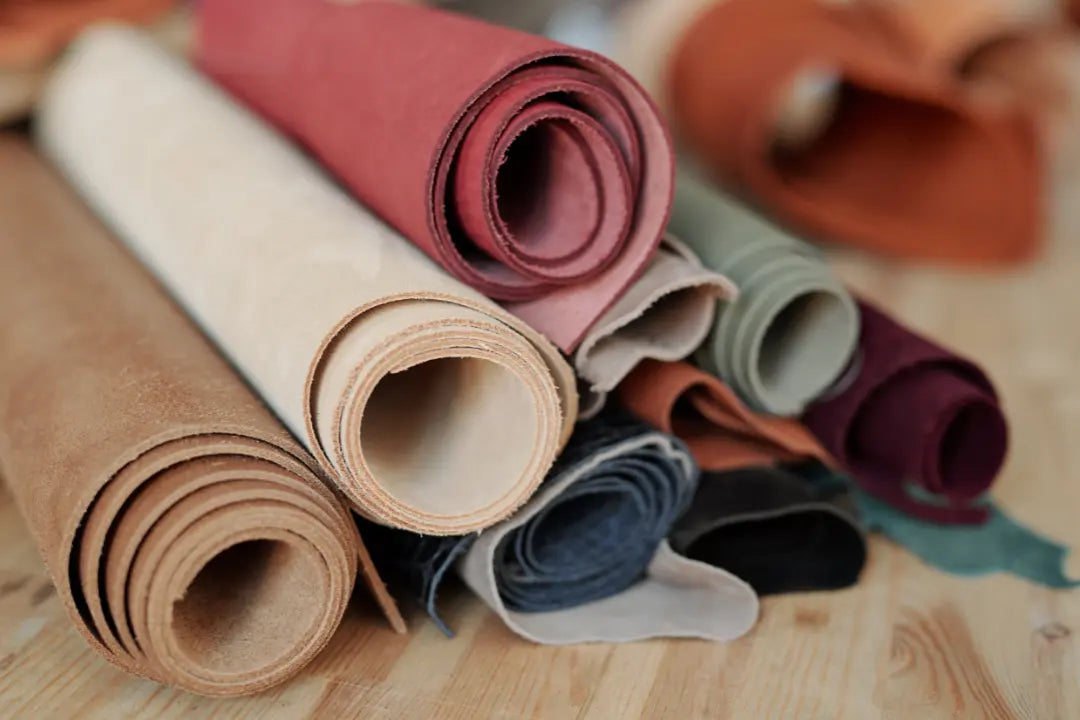
How to Buy Right Leather for Your Leather Projects
Share
So, you've got a brilliant leather project in mind—whether it's crafting a sleek wallet, stitching up a stylish bag, or fashioning a rugged belt. But wait! Before you dive headfirst into your creative endeavor, there's one crucial step you can't afford to overlook: selecting the right leather.

Fear not, fellow leather enthusiast! In this guide, we'll walk you through the maze of options and considerations to ensure you're armed with the knowledge needed to make the perfect choice for your leather projects.
Understanding Leather Basics: What Makes a Good Hide?
Before we delve into the nitty-gritty of purchasing leather, let's start with the fundamentals. What exactly makes a hide ideal for your leather projects? Here's a breakdown:
Quality Matters: Grades of Leather
1. Full Grain : Considered the creme de la creme of leather, full-grain is prized for its natural beauty and durability. It retains the entirety of the hide's original texture, making it perfect for projects that demand strength and character.
2. Top Grain : Slightly lower on the quality scale but still excellent, top-grain leather undergoes some sanding or buffing to remove imperfections. It's smooth, versatile, and often used in high-end products.
3. Genuine Leather : Don't be fooled by the name—genuine leather isn't necessarily the best option. While it's real leather, it's often made from lower-quality hides and can lack the durability and aesthetic appeal of full or top grain.
Tanning Methods: From Veg-Tan to Chrome
Leather isn't just about quality—it's also about how it's processed. Different tanning methods yield distinct characteristics, so choose wisely!- Vegetable Tanned : Traditional and eco-friendly, veg-tanned leather develops a rich patina over time and ages beautifully. Ideal for crafting artisanal goods with a rustic charm.
- Chrome Tanned : Quick and cost-effective, chrome tanning produces soft, supple leather perfect for garments and upholstery. However, it may lack the longevity of veg-tanned hides.
How to Buy the Right Leather for Your Leather Projects: A Step-by-Step Guide
Now that you're armed with the basics, it's time to embark on your leather-buying journey! Follow these steps to ensure you snag the perfect hide for your project:Step 1: Determine Your Project Needs
Before hitting the leather shop, ask yourself:
- What type of project am I undertaking?
- Do I need a sturdy leather for durability, or is softness more important?
- What color and texture am I aiming for?
Step 2: Assess Leather Quality
When inspecting potential hides, keep these tips in mind:
- Look for even coloring and minimal blemishes.
- Check the thickness and flexibility of the leather.
- Smell the leather—it should have a natural, pleasant scent.
Step 3: Consider Leather Grade and Type
Decide which grade and type of leather best suit your project:
- For rugged items like belts or tool pouches, opt for full-grain leather.
- If you're crafting a sleek wallet or bag, top-grain leather may be more suitable.
- Genuine leather can work for budget-friendly projects but may not offer the same longevity.
Step 4: Evaluate Tanning Method
Choose a tanning method that aligns with your project's needs:
- Veg-tanned leather for classic, long-lasting goods.
- Chrome-tanned leather for soft, pliable items.
Conclusion
Congratulations! You've now mastered the art of buying the right leather for your leather projects. Armed with knowledge about leather grades, tanning methods, and essential considerations, you're ready to embark on your creative journey with confidence. Remember to prioritize quality, assess your project's needs, and choose a hide that speaks to your craftsmanship. With the perfect leather in hand, there's no limit to what you can create! Happy crafting!
FAQs: Common Leather-Buying Queries Answered
Q1: Is genuine leather always a good option for budget projects?While genuine leather is affordable, it may not provide the durability or aesthetic appeal you desire. Consider other options based on your project's requirements.
Q2: Can I use veg-tanned leather for garments?
While veg-tanned leather can be used for garments, it tends to be stiffer and may require breaking in. Chrome-tanned leather is often preferred for clothing due to its softness.
Q3: How can I tell if leather is genuine?
Genuine leather should have a distinct smell and exhibit natural imperfections. Be wary of overly perfect, plastic-like surfaces.
